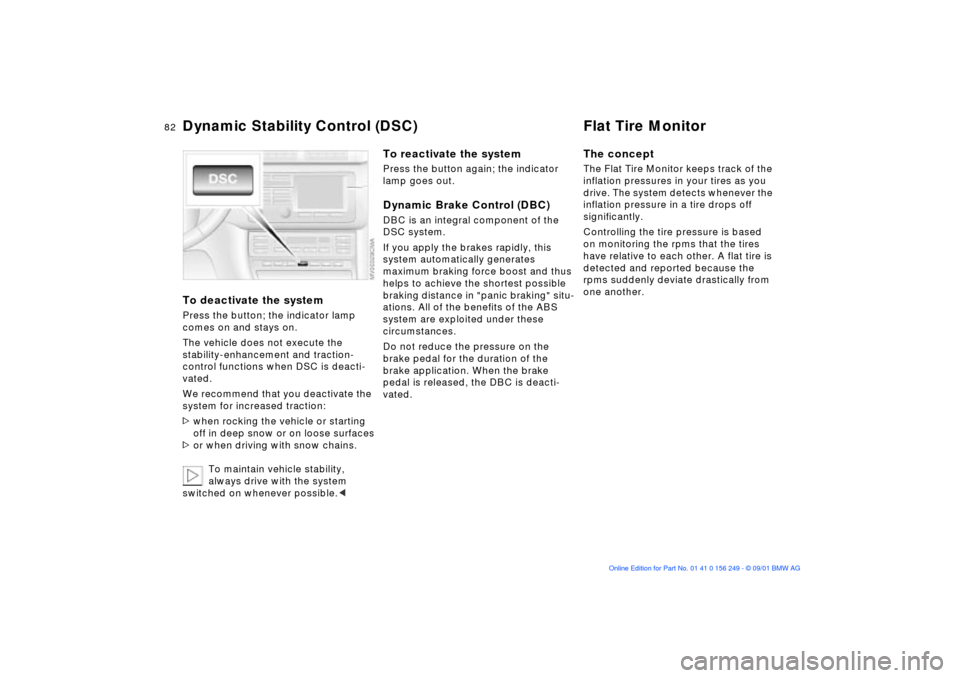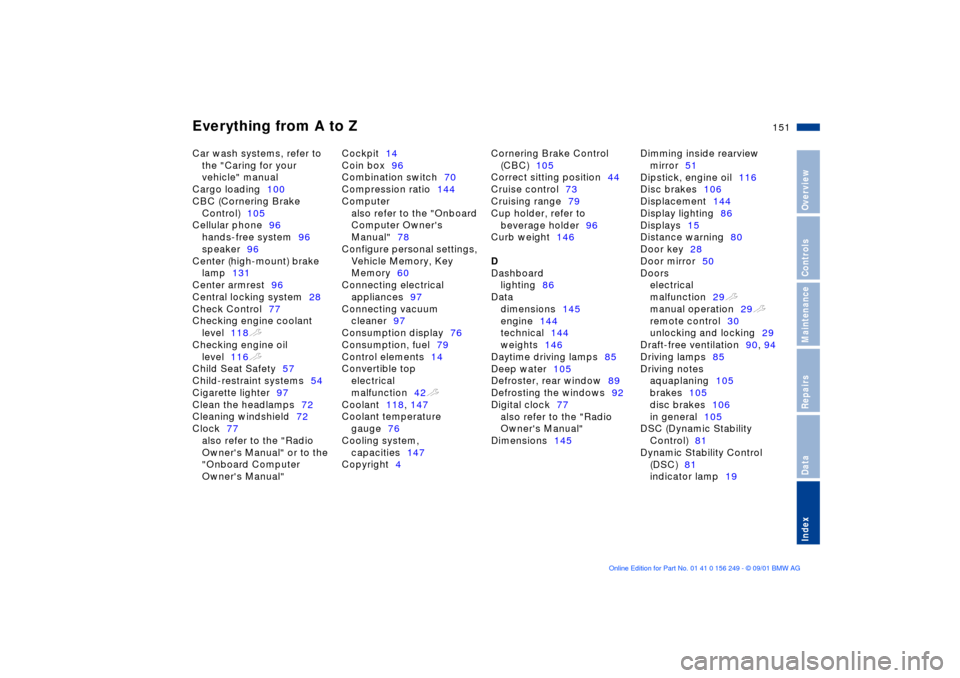brakes BMW M3 CONVERTIBLE 2002 E46 Owner's Manual
[x] Cancel search | Manufacturer: BMW, Model Year: 2002, Model line: M3 CONVERTIBLE, Model: BMW M3 CONVERTIBLE 2002 E46Pages: 159, PDF Size: 2.19 MB
Page 74 of 159

74n
Cruise control To deceleratePress button (Ð) briefly:
When cruise control is active, every tap
of the button reduces the speed by
approx. 0.6 mph (1 km/h).
Press and hold button (Ð):
With the cruise control active, the
system automatically reduces the
throttle opening to slow the vehicle.
When you release the button, the
system stores and maintains the
current speed.
To interrupt the cruise controlWhen the system is activated, press the
button. The indicator lamp stays on.
You can use the cruise control again
whenever you want by calling up the
speed that was stored last.
In addition, cruise control is interrupted
automatically:
>If the brakes are applied
>When pressing down the clutch pedal
>If you exceed or fall below the
programmed speed for an extended
period (by depressing the acceler-
ator, for example)
>Sequential M gearbox
* SMG II, refer
to page 64: when shifting in the
sequential mode.
Recall the stored speedPress button:
The vehicle accelerates to and main-
tains the last speed stored.
Page 82 of 159

82n
Dynamic Stability Control (DSC) Flat Tire MonitorTo deactivate the systemPress the button; the indicator lamp
comes on and stays on.
The vehicle does not execute the
stability-enhancement and traction-
control functions when DSC is deacti-
vated.
We recommend that you deactivate the
system for increased traction:
>when rocking the vehicle or starting
off in deep snow or on loose surfaces
>or when driving with snow chains.
To maintain vehicle stability,
always drive with the system
switched on whenever possible.<
To reactivate the systemPress the button again; the indicator
lamp goes out.Dynamic Brake Control (DBC)DBC is an integral component of the
DSC system.
If you apply the brakes rapidly, this
system automatically generates
maximum braking force boost and thus
helps to achieve the shortest possible
braking distance in "panic braking" situ-
ations. All of the benefits of the ABS
system are exploited under these
circumstances.
Do not reduce the pressure on the
brake pedal for the duration of the
brake application. When the brake
pedal is released, the DBC is deacti-
vated.
The conceptThe Flat Tire Monitor keeps track of the
inflation pressures in your tires as you
drive. The system detects whenever the
inflation pressure in a tire drops off
significantly.
Controlling the tire pressure is based
on monitoring the rpms that the tires
have relative to each other. A flat tire is
detected and reported because the
rpms suddenly deviate drastically from
one another.
Page 105 of 159

105n
OverviewControlsMaintenanceRepairsDataIndex
Brakes: do not rest your foot on
the brake pedal while driving.
Even light but consistent pedal pres-
sure can lead to high temperatures,
brake wear and possibly even brake
failure.
Aquaplaning: when driving on wet or
slushy roads, reduce road speed. If you
do not, a wedge of water can form
between tires and road surface. This
phenomenon is referred to as aqua-
planing, or hydroplaning, and can lead
to partial or complete loss of traction,
vehicle control and braking effective-
ness.
Driving through water: do not drive
through water on the road if it is deeper
than 1 foot (30 cm), and then only at
walking speed. Otherwise the vehicle
can sustain damage to the engine, the
electrical systems and the transmis-
sion.<
The conceptThe Antilock Brake System (ABS) keeps
the wheels from locking while braking,
thereby enhancing active driving safety.Braking with ABSIf you are in a situation that requires full
braking, you will exploit the full benefits
of the ABS system if you apply
maximum brake pressure ("panic
stop"). Since the vehicle maintains
steering responsiveness, you can
nevertheless avoid possible obstacles
with a minimum of steering effort.
Pulsation at the brake pedal combines
with sounds from the hydraulic circuits
to indicate to the driver that ABS is in
its active mode.Cornering Brake Control (CBC)CBC is an advanced engineering
design of the ABS. When braking while
cornering at high speed or braking
during high lateral acceleration, or
when braking during a lane change,
vehicle stability is improved and
steering response is enhanced.
Brake fluid level Low brake fluid level in the reservoir
combined with longer than usual pedal
travel may indicate a defect in one of
the brake system's hydraulic circuits.
Proceed to the nearest BMW
center. Higher brake application
pressure may be necessary when stop-
ping, and the vehicle may exhibit a
slight tendency to pull to one side.
Brake distances may even be longer.
Please remember to adapt your driving
style accordingly.<
Driving notes Antilock Brake System Brake system
Page 106 of 159

106n
Brake system Hardtop
*
Disc brakesWhen the vehicle is driven only occa-
sionally, during extended periods when
the vehicle is not used at all, and in
operating conditions where brake appli-
cations are less frequent, there is an
increased tendency for corrosion of the
rotors and accumulation of contamina-
tion on the brake pads. This occurs
because the minimal pressure that must
be exerted by the pads to clean the
rotors by brake applications is not
reached.
Corrosion on brake rotors is signaled by
a running or pulsation during braking;
even extended subsequent braking will
not cure this phenomenon.
It is a good idea to periodically dry the
brakes with a gentle application when
driving in rain and on wet roads. Watch
traffic conditions to ensure that this
maneuver does not endanger other
road users. The heat generated in this
process helps dry the pads and rotors
to ensure that your brake system will
respond with undiminished efficiency
when you need it.Extended or steep mountain descents
should be driven in the gear in which
only minimal periodic brake applica-
tions are required. This helps avoid
placing excessive loads on the brake
system. Stay within the allowable
engine speed range. For further infor-
mation, refer to page 75.
Do not coast with the clutch
depressed or with the gearshift
lever in idle position. Do not coast with
the engine shut off. If you do so the
engine provides no braking effect and
there is no power assist for braking or
steering when the engine is not
running.<
Brake pads
For your own safety: use only
brake pads which BMW has
approved for your specific vehicle
model. BMW cannot evaluate non-
approved brake pads to determine if
they are suited for use, and therefore
cannot ensure the operating safety of
the vehicle if they are installed.<
It is not necessary to remove the fabric
top even in the winter, when the
hardtop is generally in constant use.
But you can also remove it at any time
with no problem. Before the fabric top
is stored in the convertible top
compartment, it must be absolutely dry
in order to avoid water spot and mildew
from forming.
The hardtop offers reading lamps and
clothing hooks that can be used just by
pressing. In addition, a roof-rack
assembly is possible. In this regard,
please contact your BMW center.
When suspending articles of
clothing from the hooks, be sure
that they will not obstruct the driver's
vision. Do not hang heavy objects on
the hooks. If you do so, they could
cause personal injury during braking or
evasive maneuvers.<
Page 140 of 159

140n
Towing the vehicleUse only a nylon towing strap to tow
the vehicle, since the inherent resil-
ience of this material helps protect both
vehicles from sudden jerking move-
ments.
The towed vehicle should always
be the lighter of the two vehicles.
If this is not the case, it will not be
possible to control vehicle handling.
Never attempt to use your vehicle to
push another vehicle, since damage to
the energy-absorbing bumpers could
result.
Towing a vehicle1. Gearshift lever in neutral
2. Towing speed:
Max. 45 mph (70 km/h)
3. Towing distance:
Max. 95 miles (150 km)
4. Leave the ignition key at position 1 to
ensure that the brake lamps, turn
signal indicators, horn and wind-
shield wipers remain operative, and
to prevent the steering lock detent
from engaging
5. Switch on the hazard warning system
(observe applicable legal regula-
tions).
Find some means of identifying the
vehicle in tow, for instance, place a sign
or warning triangle in the rear window.
Make sure that the ignition key
remains in position 1 even when
the electrical system has failed to
prevent the steering lock from
engaging.
The steering and brakes are without
power-assist when the engine is off.
This means that increased effort is
required for steering and braking.c
Vehicles with sequential M gearbox
*
SMG II:
To push or tow, engage selector lever
in position 0.
Never work on the vehicle with a
driving position engaged.c
Page 150 of 159

Everything from A to Z
A
ABS (Antilock Brake System) 19, 105
Accessories 10
Activated-charcoal filter 94
Adding brake fluid 119t
coolant 118t
engine oil 116t
washer fluid 115t
Adjusting head restraints 46
lumbar support 45
mirrors 50
seats 45
steering wheel 50
temperature 89
thigh support 45
Air conditioner 89, 93
Air distribution 89
automatic 92
Air outlets 88, 91
Air pressure, tires 109
Air supply 89, 92
Airbags 52
warning lamp 18 Alarm system
37
avoiding unintentional
alarm 38
indicator lamp 38
interior motion sensor 37
tilt alarm sensor 37
Antifreeze 118
radiator 118
Antilock Brake System (ABS) 19, 105
Anti-theft alarm system 37
Anti-theft protection 28
Approved weights 146
Aquaplaning 105, 109
Armrest 96
Ashtray front 97
rear 97
AUC (Automatic recirculated-air
control) 93
Automatic climate control 88, 91
Automatic cruise control 73
Automatic headlight
control 85
Automatic recirculated-air control (AUC) 93 Automatic windshield
washer 72
Auxiliary terminal for jump- starting 114t
Average fuel consumption 79
Average speed 79
Avoiding unintentional alarm 38
B
Backrest unlocking 47
Backup lamps 64
bulb replacement 129t
Battery 136
add distilled water 136t
charge current 17
charging 136t
maintenance 136
Belts 48
Beverage holder 96
Blower 89, 92
BMW Maintenance System 120
Bore 144
Bottle holder, refer to beverage holder 96 Brake fluid change
76
Brake fluid level 105
indicator lamp 17
Brake lamps bulb replacement 129t
center 131
Brake system brake fluid level 105
brake fluid level, warning
lamp 105
brake pads 106
brake pads, indicator
lamp 19
disc brakes 106
indicator lamp 17
malfunction 105
Break-in procedure 104
Bulbs and lamps 126
C
California Proposition 65 Warning 121
Can holder, refer to beverage holder 96
Capacities 147
Car care, refer to the "Caring
for your vehicle" manual
Car telephone 96
Page 151 of 159

Everything from A to Z
151n
OverviewControlsMaintenanceRepairsDataIndex
Car wash systems, refer to
the "Caring for your
vehicle" manual
Cargo loading100
CBC (Cornering Brake
Control)105
Cellular phone96
hands-free system96
speaker96
Center (high-mount) brake
lamp131
Center armrest96
Central locking system28
Check Control77
Checking engine coolant
level118t
Checking engine oil
level116t
Child Seat Safety57
Child-restraint systems54
Cigarette lighter97
Clean the headlamps72
Cleaning windshield72
Clock77
also refer to the "Radio
Owner's Manual" or to the
"Onboard Computer
Owner's Manual" Cockpit14
Coin box96
Combination switch70
Compression ratio144
Computer
also refer to the "Onboard
Computer Owner's
Manual"78
Configure personal settings,
Vehicle Memory, Key
Memory60
Connecting electrical
appliances97
Connecting vacuum
cleaner97
Consumption display76
Consumption, fuel79
Control elements14
Convertible top
electrical
malfunction42t
Coolant118, 147
Coolant temperature
gauge76
Cooling system,
capacities147
Copyright4 Cornering Brake Control
(CBC)105
Correct sitting position44
Cruise control73
Cruising range79
Cup holder, refer to
beverage holder96
Curb weight146
D
Dashboard
lighting86
Data
dimensions145
engine144
technical144
weights146
Daytime driving lamps85
Deep water105
Defroster, rear window89
Defrosting the windows92
Digital clock77
also refer to the "Radio
Owner's Manual"
Dimensions145 Dimming inside rearview
mirror51
Dipstick, engine oil116
Disc brakes106
Displacement144
Display lighting86
Displays15
Distance warning80
Door key28
Door mirror50
Doors
electrical
malfunction29t
manual operation29t
remote control30
unlocking and locking29
Draft-free ventilation90, 94
Driving lamps85
Driving notes
aquaplaning105
brakes105
disc brakes106
in general105
DSC (Dynamic Stability
Control)81
Dynamic Stability Control
(DSC)81
indicator lamp19